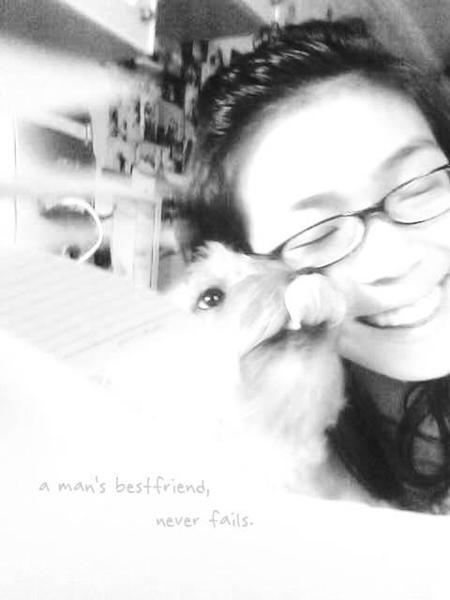[qik url=”http://72.5.78.4/video/1832417″%5D
doggie doggie.
•July 21, 2007 • Leave a Comment
Top 10 Tips For Feeding Your Adult Dog
Adult dogs require sufficient nutrients to meet energy needs and to maintain and repair body tissues. The amount you feed your adult dog should be based on his or her size and energy output. Activity levels vary dramatically between pets, and will play an important role in determining caloric intake.
As a responsible dog owner, one of the most common pitfalls you’ll have to watch out for is overfeeding. Attempts to shower our dogs with love by means of big meals and tons of tasty treats are sweet, but misguided. In dogs, as with humans, extra weight can lead to health problems. Be sure to indulge your four-legged friend with affection, not food—and read the following tips for more helpful advice from our ASPCA pet nutrition experts:
1. Lassie Versus Lazy
House pets vary widely in their activity levels. An animal with a “normal” activity level should receive what we call “maintenance” energy. A pampered lap dog may require 10 percent below maintenance, while an active pet who exercises regularly outdoors may require maintenance plus 20 to 40 percent.
2. Working Dogs: Earning Their Dinner
The dietary needs of working canines, such as police dogs, guide dogs and cattle dogs, will depend on their occupations. Energy needs will increase with the work level and/or stress level. A dog with a moderate work load may require an energy increase of 40 percent compared to maintenance, whereas a dog with a high work load may require an extra 50 to 70 percent.
3. Do You Have the Hardest Working Pup in Show Business?
Show dogs must be fed a balanced diet with the correct amount of energy, because deficiencies may be reflected in coat quality. While on the show circuit, the pet’s energy requirement may increase by 20 percent or more. The dog should be fed maintenance amounts when not on the show circuit.
4. Get Well Soon
An animal recovering from surgery or suffering from a disease may have an increased nutritional requirement for repair, healing and fighting infection.
5. Whatever the Weather
Environment influences energy needs, and extreme hot or cold weather can increase a dog’s energy needs. Both keeping warm and keeping cool require extra energy expenditure, so you may wish to talk to your pet’s vet about what to do when the mercury dips and/or soars.
6. How, What, When
Dogs may be fed successfully in a number of ways that meet both the owner’s and the animal’s needs and circumstances. These methods include portion-control feeding, free-choice feeding and timed feeding.
– The portion-control feeding entails measuring your pet’s food and offering it as a meal, thereby controlling the amount of food that can be consumed. This method is used for weight control programs and for animals that might overeat if fed free-choice. Food can be provided in one or more meals daily.
– Free-choice feeding is also known as “ad lib” feeding or “free feeding.” Food is available at all times, as much as the pet wants, whenever the pet wants. Most nursing mothers are fed by the free-choice method. This method is most appropriate when feeding dry food, which will not spoil if left out.
– The timed feeding method involves making a portion of food available for the pet to eat for a specified period of time. For example, the food can be placed in the dog’s bowl for thirty minutes. After that time, if the pet has not consumed the food, it is removed.
7. Two Square Meals a Day
We recommend all dogs be fed twice daily. Simply divide the amount suggested on the label of your pet’s food into two meals, spaced eight to twelve hours apart. You may need to adjust portions as you learn your dog’s ideal daily “maintenance” amount.
8. What’s Up, Doc?
Pet owners should always consult with their dog’s veterinarian to determine the best feeding schedule and types of foods for their pets.
9. A Growing Problem
Some dogs will overeat when fed free-choice method, which can result in obesity. If your pet eats free-choice and has put on too much weight, you will need to switch to portion-control feeding.
10. Take Five (Or Less)
We all love to give our dogs treats. However, treats should be given in moderation and should represent five percent or less of the dog’s daily food intake. The rest should come from a nutritionally complete dog food. When using treats frequently, such as during training exercises, try to use the smallest pieces you can.
http://www.aspca.org/site/PageServer?pagename=pets_petnutritionadult_dog
The many beautiful dawgs. .
•July 2, 2007 • Leave a Comment

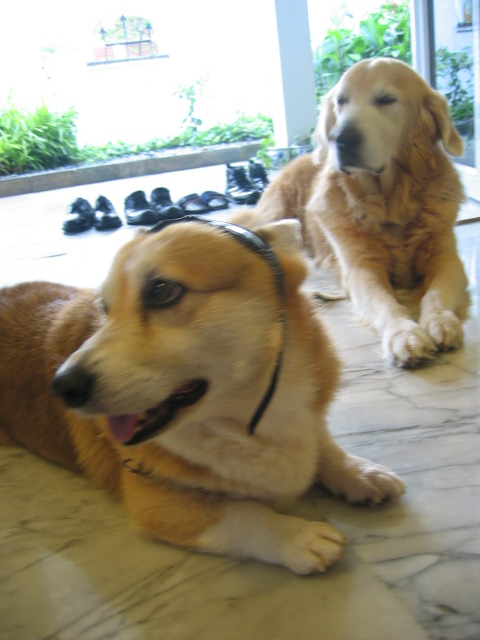

The beautiful dogs with courtesy from some of the beautiful owners.
These people have grooming services that is at their convenience and readily available at any nearby destination. Of course the market for dogs in the US is much greater as compared to the tiny dot Singapore. Check out how PRO they are, the interior is insatiably done. I would bring my doggie there for grooming, would you?
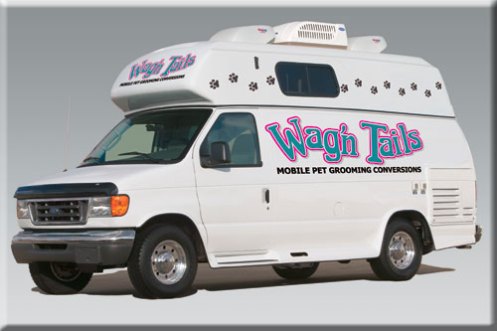
A day of nothing more but proposals and more proposals. Thank you sweets for the beautiful layout.A digression from the usual dog stories. Other than Couture Makeup, what other types of exorbitant and embellished makeups are there? Check this out.

New York is Beautiful.
•July 1, 2007 • Leave a CommentA snap shot of the beautiful NY city and a New York doggie. Let’s go on a holiday againnnnn. Mind you all the dogs there have pretty good lives. People bring their dogs into like the clothes stores/departmental stores. Anywhere but the supermarket of course.
The NY doggie.

On Pet Grooming
The Silky Terrier has a glossy, fine, straight coat that sheds little to no hair. However, a lot of grooming is needed to keep the coat lustrous and free of mats and tangles. Every day, this dog should be combed and brushed for about 15 minutes. Regular bathing is also necessary, though it’s important that this dog be thoroughly warmed and dried afterwards. The coat should be trimmed occasionally, with the hair on the legs and the knees kept short, and the hair over the eyes can be held up in a topknot.The Silky Terrier has a glossy, fine, straight coat that sheds little to no hair. However, a lot of grooming is needed to keep the coat lustrous and free of mats and tangles. Every day, this dog should be combed and brushed for about 15 minutes. Regular bathing is also necessary, though it’s important that this dog be thoroughly warmed and dried afterwards. The coat should be trimmed occasionally, with the hair on the legs and the knees kept short, and the hair over the eyes can be held up in a topknot.
More tips on grooming your four legged friends check this out.
It is alive.
•June 29, 2007 • Leave a Comment
Dogs are beautiful creatures. Let’s not put them to sleep, let’s not put them to waste. Let’s not change our minds as and when we please. It’s just not fair. Not one bit fair. This a site for dog adoptions. So if you do have the time and loveee to care for a doggie. Do check them out.
my dawgs.
•June 27, 2007 • 1 Comment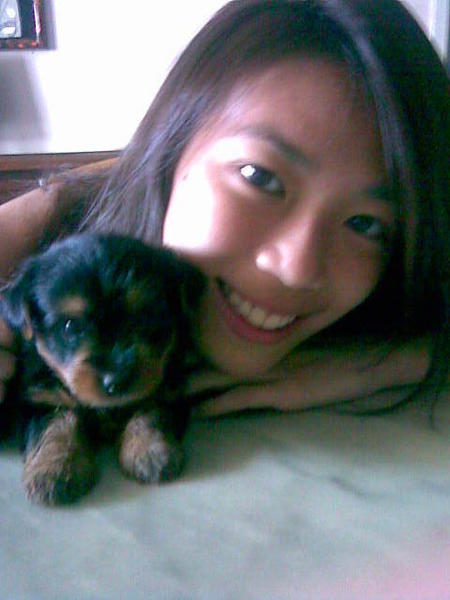
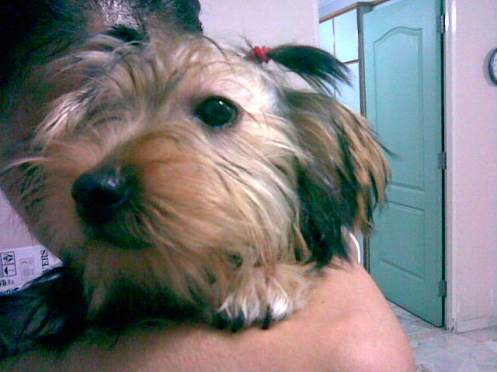
Can Dogs Eat Chocolate ?
It is a very bad idea to feed your dogs chocolate because it contains a chemical called theobromine. Dogs can’t metabolize theobromine as efficiently as humans so it builds up in their systems until it reaches a toxic level of concentration, which may lead to a variety of problem with the most serious being death due to cardiac arrest. Keep in mind that the lesser the dog weighs, the more you should be worried because the toxicity level is higher.
And so, as pet nutrition states. As we dog owners are so tempted to feed our beloved four legged friends, it may do them more harm than good. We love them, dont we? Let’s keep them healthy and safe!
The bold and beautiful Dogs.
•June 26, 2007 • Leave a Comment
My naughty puppy being the bully she always is.

My friend’s beautiful Dalmation.
TOP 10 TIPS FOR FEEDING YOUR PUPPY
If you’re responsible for taking care of puppies in the first few months of their lives, you need to be prepared to move them from a diet of mom’s milk to regular puppy food. Our ASPCA nutrition experts tell you when and how it’s done, along with some other important info, in these easy top ten tips:
1. Mother Knows Best
Newborn puppies receive complete nutrition from their mother’s milk for the first four weeks of life. Mom’s milk is 100 percent perfect for their needs, so there is no need to feed them anything else.
2. Substitutions Allowed
In the event that the mother dog is ill or doesn’t produce enough milk—or if the pups are found as orphans—it may be necessary to feed a commercial milk replacer. If you find yourself in this situation, contact your veterinarian for product and feeding recommendations.
3. Love at First Bite
Puppies generally begin eating puppy food around three or four weeks of age. Start with small quantities, and gradually increase the amount of puppy food.
4. Tasteful Toys
Puppies often play with their food when it is first introduced, but they will quickly learn what to do with it! By the time the pups are completely weaned at seven to eight weeks old, they should be eating their dry food consistently.
5. Hey Ma, What’s for Dinner?
Puppies require up to twice the energy intake of adults and, depending on the breed, will need to be fed a food that contains 25- to 30-percent protein.
6. Small Breed Needs
Small breeds of dogs—those weigh 20 pounds or less at maturity—reach mature body weight in nine to twelve months. As puppies, they can be fed free-choice. When food is readily available, most small-breed dogs will develop good eating habits and not become overweight. However, if you have other pets, you should probably feed your small-breed dog by the portion control method.
7. No Such Thing as a Free Lunch
Most medium-breed puppies (adult size between 20 and 50 pounds) and all large- or giant-breed pups (more than 50 pounds as adults) are best fed with the portion-control method.
8. Growth Spurts Can Hurt
If they are allowed to overeat, they can consume too many calories, grow too rapidly and develop bone growth problems. Clinical signs often seen with bone growth disease include bowing of the front legs. Sometimes, these signs are misdiagnosed as calcium deficiency (also known as rickets). Radiographs are crucial for an accurate diagnosis.
9. Easy Does It
Do not overfeed in an attempt to accelerate a puppy’s growth rate. Remember, the adult size of a dog is determined genetically—not by how fast the animal grows. Controlled feeding of a balanced diet specifically made for large- and giant-breed puppies facilitates optimal skeletal development. It is important to aim for a slower rate of growth with large and giant breed puppies.
10. Treats for Your Sweets
It is okay to feed your puppy treats. However, treats should make up no more than five percent of your puppy’s daily nutrient intake. The rest of his or her diet should come from a high-quality puppy food.
http://www.aspca.org/site/PageServer?pagename=pets_petnutritionpuppy
Escapade.
•June 25, 2007 • 2 CommentsThis is for all Man’s bestfriend, though cliche, i beg to differ.
It was a day of escapades. Into my sleep that is. I was reading Pet Product news and guess what i found out? Certain dogs these days have the capability to sniff out in man’s breathe that he has lung cancer. How awesome!! Dogs are in fact the smartest things on earth, not to mention both my dogs both are infectiously hilarious.




